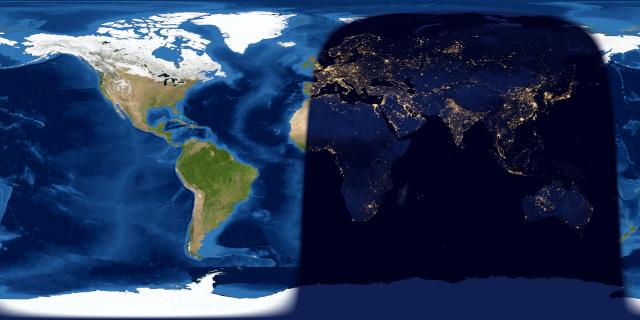The moon will look full to the eye on both March 27 and 28, 2021. The crest of the full moon falls on March 28 at 18:48 UTC (2:48 p.m. Eastern Daylight Time). In North America, we call the March full moon the Worm Moon, Crow Moon or Sap Moon. This 2021 March full moon presents the first of three springtime full moons in the Northern Hemisphere, and the first of three autumn full moons in the Southern Hemisphere. This full moon also sets the date of Easter, which, in 2021, is April 4.
Lunar perigee – from two root words meaning “near” and “Earth” – will come on March 30, 2021. Thus this full moon is somewhat closer to us than usual. It’s 2021’s fourth-closest full moon. And you might hear some people calling this full moon a supermoon … but is it? The next three full moons in April, May and June 2021 will be closer yet, with the May 26, 2021, full moon presenting this year’s closest supermoon.
Read more: March full moon a supermoon?
Visit Sunrise Sunset Calendars to find out when the moon turns full in your time zone. Be sure to check the moon phases box.
This is also the closest full moon to the March equinox, which fell on March 20, 2021, at 09:37 UTC. That’s the spring equinox for us in the Northern Hemisphere, but the autumn equinox south of the equator. Thus, for the Southern Hemisphere, this March full moon could be called their Harvest Moon, famous for ushering in a succession of moonlit nights in the season of waning daylight.
Any full moon rises at or around sunset, and rises an average of 50 minutes later with each passing day. Around the time of the Harvest Moon, the lag time between successive moonrises is reduced to a yearly minimum. For instance, at and around 40 degrees south latitude, the moon is now rising some 30 to 35 minutes (instead of 50 minutes) later daily for the next several days.
Meanwhile, in the Northern Hemisphere, this March full moon is the closest full moon to the spring equinox. Hence, the lag time between successive moonrises reaches a yearly maximum, as with any near-spring equinox full moon. For instance, at 40 degrees north latitude, the moon is now rising some 75 minutes (rather than 50 minutes) later daily.
The converse holds true for moonset. The moon – on the average – sets some 50 minutes later daily. At present, however, the lag time between successive moonsets is at maximum for the Southern Hemisphere, yet at a minimum in the Northern Hemisphere. At 40 degrees south latitude, the moon now sets around 75 minutes (instead of 50 minutes) later daily; whereas at 40 degrees north latitude, the moon now sets some 30 to 35 minutes (not 50 minutes) later.
Before the advent of artificial lighting, our ancestors must have been well aware of these seasonal vagaries of the wayward moon.

Bottom line: The whole globe enjoys a full-looking moon on March 27 and 28, 2021. No matter where you live worldwide, watch for the first full moon of the season to shine from dusk until dawn.











